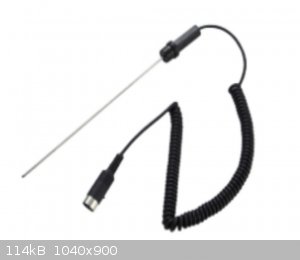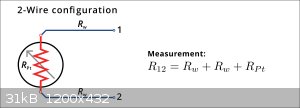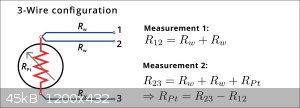VeritasC&E
Hazard to Others
  
Posts: 176
Registered: 29-1-2018
Member Is Offline
Mood: No Mood
|
|
DIY Cheap "Proprietary" Thermal Probe?
Is it possible to make a probe that looks like the one in the first image for a port that looks like the one in the second image?
The probe is called "PT-1000" (not sure if that's a precision standard or the name of the port).
It measures temperature between -50 and +800C.
And it costs dozens of €/$ (if not over a hundred).
Now you can get K-Type probes from China that measure in the same temperature range, with fair if not equivalent precision, and cost only a few €/$.
Is there a way to adapt such a K-type probe maybe?
 
|
|
|
Fulmen
International Hazard
    
Posts: 1716
Registered: 24-9-2005
Member Is Offline
Mood: Bored
|
|
The name implies it's a Pt1000 sensor, you should be able to verify this by measuring the plug for a 1000 ohm resistance across two pins.
We're not banging rocks together here. We know how to put a man back together.
|
|
|
VeritasC&E
Hazard to Others
  
Posts: 176
Registered: 29-1-2018
Member Is Offline
Mood: No Mood
|
|
Quote: Originally posted by Fulmen  | | The name implies it's a Pt1000 sensor, you should be able to verify this by measuring the plug for a 1000 ohm resistance across two pins.
|
Hi Fulmen!
I'm not sure what this means. Is the precision of the sensor proportional to its resistance?
If I find a 1 kOhm K-Type sensor, how can I adapt it to make a sensor substituting the expensive "proprietary" type sold?
|
|
|
Fulmen
International Hazard
    
Posts: 1716
Registered: 24-9-2005
Member Is Offline
Mood: Bored
|
|
There is no way to adapt a Pt1000 circuit to use a K-element. But you should be able to find a suitable Pt1000-probe from China.
We're not banging rocks together here. We know how to put a man back together.
|
|
|
JohnnyBuckminster
Harmless

Posts: 40
Registered: 6-6-2018
Member Is Offline
|
|
PT-1000: PT indicates that the sensor is a Platinum wire and the number 1 000 indicates the resistance in Ohm at 0 Centigrades.
Similarly, PT-100 indicates a probe with a Platinum wire with the resistance of 100 Ohm at 0 Centigrades.
The probe can be configured to use 2,3 or 4 wires depending on the level of precision required.
A quality PT probe will far exceed the precision and accuracy that can be achieved with a thermocouple. However, the response time is typically quite
slow, and the size is larger.
[Edited on 2022-8-18 by JohnnyBuckminster]
|
|
|
VeritasC&E
Hazard to Others
  
Posts: 176
Registered: 29-1-2018
Member Is Offline
Mood: No Mood
|
|
Quote: Originally posted by Fulmen  | There is no way to adapt a Pt1000 circuit to use a K-element. But you should be able to find a suitable Pt1000-probe from China.
|
Thank you!
|
|
|
VeritasC&E
Hazard to Others
  
Posts: 176
Registered: 29-1-2018
Member Is Offline
Mood: No Mood
|
|
Quote: Originally posted by JohnnyBuckminster  |
PT-1000: PT indicates that the sensor is a Platinum wire and the number 1 000 indicates the resistance in Ohm at 0 Centigrades.
Similarly, PT-100 indicates a probe with a Platinum wire with the resistance of 100 Ohm at 0 Centigrades.
The probe can be configured to use 2,3 or 4 wires depending on the level of precision required.
A quality PT probe will far exceed the precision and accuracy that can be achieved with a thermocouple. However, the response time is typically quite
slow, and the size is larger.
[Edited on 2022-8-18 by JohnnyBuckminster] |
That's very useful information. Thank you very much!
May I ask why platinum? Is it for corrosion resistance?
What approximate differences in precision/accuracy and response times are we talking about here between thermocouple and PT probe?
Based on my use I'd happily trade some minute precision for significantly faster response to avoid having a temparture reading lagging behind the true
temperature (especially if the probe is 50x cheaper!)
While one may be more precise/accurate in theory, if the response time is too long compared to the other it could be innacurate in practice. I'm
thinking readings at a column head for instance when small fractions change the head vapor temperature fairly fast.
|
|
|
VeritasC&E
Hazard to Others
  
Posts: 176
Registered: 29-1-2018
Member Is Offline
Mood: No Mood
|
|
For $15 from china you get a PT1000 sensor limited to 400C (highest I could find: most are limited to 200C).
As a comparison for $3 you get a K type with a limit of 1200C. So you pay +400% the price for -67% temperature range. Brilliant profiteering design
choices... 
On the PT1000 sensors there seem to be two wires of each color (blue and red); I guess this means they contain 2 sensing wires based on the
information learned from Johnny.
Does this work by taking a reading at each wire and averaging the two?
Which holes should I connect them to on the port in the picture at the beginning of the thread?
[Edited on 18-8-2022 by VeritasC&E]
|
|
|
Organikum
resurrected
    
Posts: 2337
Registered: 12-10-2002
Location: Europe
Member Is Offline
Mood: frustrated
|
|
There are two ports in your second image, the round one with 5 poles and a RS232 serial port. As the first picture shows a probe with a round
connector I guess you mean the left one on the second image?
Although Pt1000 probes are more expensive then Pt100 or even K Type ones, they don't cost hundreds of Dollars except one buys them from some
Labsupplier and they are branded.
The question is for what it is intended, what temperature range will be measured and what precision is required. I looked and saw on Aliexpress
sensors for 6 €, sleeves from SS for the same and a connector is 2 €. If the RS232 on the pic is a possible input then you can connect any sensor
to it as a transducer will be needed between sensor and the device. Transducer < 10 € at Amazon. In this case even a K type thermocouple would be
possible, but the Pt100/Pt1000 are really better, at least in the 3 or 4 wire versions which are just much more reliable and precise.
|
|
|
Twospoons
International Hazard
    
Posts: 1324
Registered: 26-7-2004
Location: Middle Earth
Member Is Offline
Mood: A trace of hope...
|
|
PT-1000 sensing elements rated to 600C can be had for under $10, from reputable suppliers like Digikey. You would still need to create a suitable
housing, and your connecting wires would need to be welded on to withstand 600C.
Key differences between RTD (of which PT-1000 is just one type) and thermocouples:
* RTDs have a resistance proportional to temperature, and they are usually very linear, with well defined temperature coefficients. They can be made
with high precision, making replacement without calibration possible. The common 4 wire sensing technique uses two wires to deliver current to the
sensing element and two wires to measure the voltage across the sensing element - this eliminates the cable and connector resistance from the
measurement.
* Thermocouples produce a small voltage dependent on the difference between the hot junction (usually the sensing end) and the cold junction (the
metering end) so they will have additional circuitry for "cold junction compensation". The EMF/temperature curve is generally not linear over large
ranges so needs additional correction to derive the correct temperature. The hot junction can be made very small, resulting in very fast response
times.
If you need precision (under 0.5%) and repeatability go RTD. If you need speed and low cost go thermocouple.
Note: The rectangular 9 pin port is a DB-9 connector, and not necessarily for RS232 - which is a physical communication protocol that could use any
type of connector. DB-9 does not equal RS232
Helicopter: "helico" -> spiral, "pter" -> with wings
|
|
|
JohnnyBuckminster
Harmless

Posts: 40
Registered: 6-6-2018
Member Is Offline
|
|
To summarize a few points already mentioned about Pt-100 / Pt-1000 probes
1. Platinum is chosen because its resistance changes nearly linearly with temperature, it is chemically very stable, and has long-term stability.
Note that the Platinum wire is in a protective shielding, typically of stainless steel or glass. The Pt wire is not in direct contact with the
substance to be measured.
2. If you know the resistance at one reference temperature, then nearly any temperature can be calculated from Callendar–Van Dusen equation. For the Pt-100 probe, the reference resistance is 100 ohm at 0 Celsius.
3. The precision and accuracy of a Pt probe depend on the quality of the material used. If a low-grade Pt is used, i.e. not 99.999 % pure, then the
error can be quite large and additional calibrations might be necessary. Watch out for Pt-100 / Pt-1000 probes that are sold for a few $.
4. Wiring Configuration
The simplest setup is the 2 wire configuration, as illustrated in the figure below. It is the simplest but also the least accurate.
The resistance measured is the sum of contributions from not only the Pt wire itself, RPt, but also from the wires used to connect to the probe,
indicted with Rw. The connecting wires themself will have a resistance that depends on the ambient temperature in the room and can introduce a
significant error.

A three-wire configuration solves this problem. See the illustration below. The Pt wire is connected to three identical connecting wires of the same
length, made from the same material, and have the same resistance Rw.
Two measurements are done. The first measurement is between pin 1 and 2 and records the resistance of the connecting wires themself. The second
measurement is between pin 2 and 3, which is the sum of all contributions. But now it is possible to solve from RPt.

And finally, some thoughts. If precision and accuracy are required, and the budget is tight, look at a DIY option, see for example https://www.adafruit.com/product/3328 . I got some fairly good results with components from Adafruit, although some calibration against reference
temperatures might be necessary if you aiming for 0.1 C precision.
[Edited on 2022-8-19 by JohnnyBuckminster]
[Edited on 2022-8-19 by JohnnyBuckminster]
|
|
|
yobbo II
National Hazard
   
Posts: 762
Registered: 28-3-2016
Member Is Offline
Mood: No Mood
|
|
There are also four wire configurations. Same idea as the three wire but an extra wire both sides.
Where are you situated.
Yob
|
|
|
VeritasC&E
Hazard to Others
  
Posts: 176
Registered: 29-1-2018
Member Is Offline
Mood: No Mood
|
|
Quote: Originally posted by JohnnyBuckminster  | To summarize a few points already mentioned about Pt-100 / Pt-1000 probes
1. Platinum is chosen because its resistance changes nearly linearly with temperature, it is chemically very stable, and has long-term stability.
Note that the Platinum wire is in a protective shielding, typically of stainless steel or glass. The Pt wire is not in direct contact with the
substance to be measured.
2. If you know the resistance at one reference temperature, then nearly any temperature can be calculated from Callendar–Van Dusen equation. For the Pt-100 probe, the reference resistance is 100 ohm at 0 Celsius.
3. The precision and accuracy of a Pt probe depend on the quality of the material used. If a low-grade Pt is used, i.e. not 99.999 % pure, then the
error can be quite large and additional calibrations might be necessary. Watch out for Pt-100 / Pt-1000 probes that are sold for a few $.
4. Wiring Configuration
The simplest setup is the 2 wire configuration, as illustrated in the figure below. It is the simplest but also the least accurate.
The resistance measured is the sum of contributions from not only the Pt wire itself, RPt, but also from the wires used to connect to the probe,
indicted with Rw. The connecting wires themself will have a resistance that depends on the ambient temperature in the room and can introduce a
significant error.
A three-wire configuration solves this problem. See the illustration below. The Pt wire is connected to three identical connecting wires of the same
length, made from the same material, and have the same resistance Rw.
Two measurements are done. The first measurement is between pin 1 and 2 and records the resistance of the connecting wires themself. The second
measurement is between pin 2 and 3, which is the sum of all contributions. But now it is possible to solve from RPt.
And finally, some thoughts. If precision and accuracy are required, and the budget is tight, look at a DIY option, see for example https://www.adafruit.com/product/3328 . I got some fairly good results with components from Adafruit, although some calibration against reference
temperatures might be necessary if you aiming for 0.1 C precision.
|
Thank you for all this information.
If I buy a simple PT1000 probe and housing, do you know if I can connect the wires directly on a plug that would fit the pictures round port? And if
so which pins corresponds to what?
|
|
|
VeritasC&E
Hazard to Others
  
Posts: 176
Registered: 29-1-2018
Member Is Offline
Mood: No Mood
|
|
Quote: Originally posted by yobbo II  |
There are also four wire configurations. Same idea as the three wire but an extra wire both sides.
Where are you situated.
Yob
|
I'm in Europe
|
|
|
JohnnyBuckminster
Harmless

Posts: 40
Registered: 6-6-2018
Member Is Offline
|
|
Quote: Originally posted by VeritasC&E  |
If I buy a simple PT1000 probe and housing, do you know if I can connect the wires directly on a plug that would fit the pictures round port? And if
so which pins corresponds to what? |
It will probably not fit directly since Pt 100 / Pt 1000 probes come configured for either 2,3, or 4 wire connection. I have not seen any standard
being used for the pin connection. You will probably have to figure that out yourself.
|
|
|
yobbo II
National Hazard
   
Posts: 762
Registered: 28-3-2016
Member Is Offline
Mood: No Mood
|
|
I have Pt 100 probes only.
Some reading here
https://uk.rs-online.com/web/p/rtd-sensors/1235584
|
|
|
VeritasC&E
Hazard to Others
  
Posts: 176
Registered: 29-1-2018
Member Is Offline
Mood: No Mood
|
|
Quote: Originally posted by JohnnyBuckminster  | Quote: Originally posted by VeritasC&E  |
If I buy a simple PT1000 probe and housing, do you know if I can connect the wires directly on a plug that would fit the pictures round port? And if
so which pins corresponds to what? |
It will probably not fit directly since Pt 100 / Pt 1000 probes come configured for either 2,3, or 4 wire connection. I have not seen any standard
being used for the pin connection. You will probably have to figure that out yourself.
|
Thank you!
I ended up buying a used fitting probe on ebay. It seemed more simple since this seemed it would be much more time intensive than I initially thought.
|
|
|
Texium
|
Thread Moved
27-8-2022 at 09:21 |